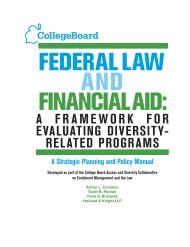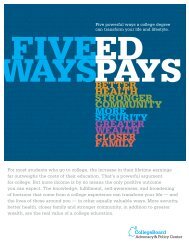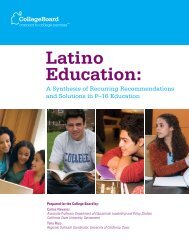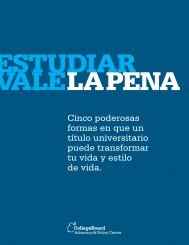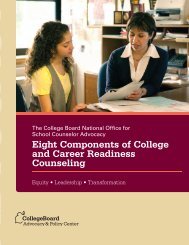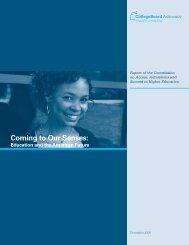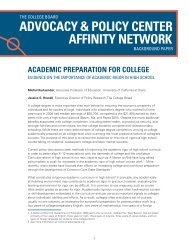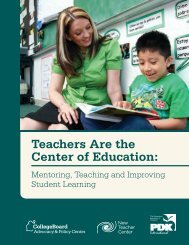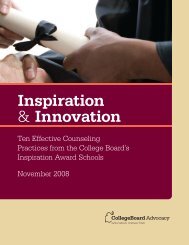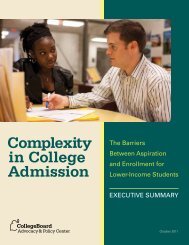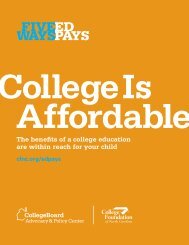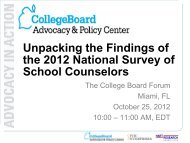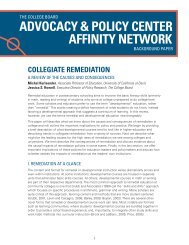Transforming the Educational Experience of Young Men of Color
Transforming the Educational Experience of Young Men of Color
Transforming the Educational Experience of Young Men of Color
You also want an ePaper? Increase the reach of your titles
YUMPU automatically turns print PDFs into web optimized ePapers that Google loves.
efforts as a wheel with schools at <strong>the</strong> hub, local education systems should be<br />
constructed and maintained as webs, with connections and relationships that<br />
relate to <strong>the</strong> center without all contacts running directly through <strong>the</strong> center.<br />
The creation <strong>of</strong> an equitable educational system that is inclusive <strong>of</strong> schools<br />
but moves beyond <strong>the</strong>m ultimately means forging new relationships, building<br />
abundant nontraditional connections and developing <strong>the</strong> ability for partners to<br />
work toge<strong>the</strong>r much more effectively and constructively. As a result <strong>of</strong> this kind<br />
<strong>of</strong> educational coherence, increasing <strong>the</strong> graduation rate would be measurable<br />
not only in school achievement data but demonstrable in <strong>the</strong> decrease in risky<br />
behaviors among teens, improved feelings <strong>of</strong> youth connectedness, a rise in <strong>the</strong><br />
teen employment rate in <strong>the</strong> city and <strong>the</strong> ability to retain and attract businesses<br />
and industry. This approach is only possible when partners recognize both <strong>the</strong><br />
problem and <strong>the</strong> opportunity and also commit to partnership as a meaningful<br />
opportunity to work across boundaries in search <strong>of</strong> better and more effective<br />
supports and pathways for male students <strong>of</strong> color and o<strong>the</strong>r vulnerable populations.<br />
1. Karl L. Alexander, Doris R. Entwisle, and<br />
Linda S. Olson, “Schools, Achievement,<br />
and Inequality: A Seasonal Perspective,”<br />
<strong>Educational</strong> Evaluation and Policy Analysis 23,<br />
no. 2 (Summer 2001), 171–191.<br />
2. Karl L. Alexander, Doris R. Entwisle, and Linda<br />
Olson, “Lasting Consequences <strong>of</strong> <strong>the</strong> Summer<br />
Learning Gap,” American Sociological Review<br />
72 (April 2007), 173–174.<br />
3. Edmund W. Gordon, Beatrice L. Bridglall,<br />
and Aundra Saa Meroe, eds., Supplementary<br />
Education: The Hidden Curriculum <strong>of</strong> High<br />
Achievement (Lanham, MD: Rowan &<br />
Littlefield, 2004).<br />
4. For example, see Joseph A. Durlak and Roger<br />
P. Weissberg, The Impact <strong>of</strong> After-School<br />
Programs That Promote Personal and Social<br />
Skills (Chicago: Collaborative for Academic,<br />
Social, and Emotional Learning, 2007). An<br />
executive summary can be found at<br />
www.casel.org/downloads/ASP-Exec.pdf.<br />
5. C. A. Lehr, D. R. Johnson, C. D. Bremer,<br />
and M. Thompson, Essential Tools:<br />
Increasing Rates <strong>of</strong> School Completion:<br />
Moving from Policy and Research to Practice<br />
(Minneapolis: University <strong>of</strong> Minnesota,<br />
Institute on Community Integration,<br />
National Center on Secondary Education<br />
and Transition, 2004), 7.<br />
6. Alliance for Excellent Education,<br />
“Understanding High School Graduation<br />
Rates,” www.all4ed.org/files/Sources_wc.pdf.<br />
Conclusion<br />
Every year, encouraged and supported by family members, a range <strong>of</strong> in-school<br />
and OST educators and o<strong>the</strong>r education stakeholders in <strong>the</strong>ir communities,<br />
millions <strong>of</strong> youth <strong>of</strong> color across <strong>the</strong> nation thrive as <strong>the</strong>y pursue a high school<br />
education. Never<strong>the</strong>less, more than one million youth annually leave <strong>the</strong> school<br />
system prior to or during high school. Their failure to graduate has long-lasting<br />
and adverse individual, community and national consequences. To provide greater<br />
context, in contemporary America, one student leaves school before graduation<br />
every nine seconds. 5 Dropouts from <strong>the</strong> class <strong>of</strong> 2008 alone will cost <strong>the</strong> United<br />
States almost $319 billion in lost wages over <strong>the</strong>ir lifetimes. 6<br />
While <strong>the</strong>re is a natural and immediate tendency to attribute educational<br />
success chiefly to individual commitment, behavior and work ethic, <strong>the</strong>re remains<br />
a large portion <strong>of</strong> responsibility that must be shared more widely and collectively.<br />
The Urban League believes that <strong>the</strong>re is no single “silver bullet” education reform<br />
or innovation that can improve <strong>the</strong> outcomes for urban youth, including simply<br />
adding more learning time to a student’s schedule, but we do believe that good<br />
work is happening all across <strong>the</strong> nation as communities come toge<strong>the</strong>r. Educators<br />
in both schools and communities have engaged in multiple activities that work,<br />
and, in some cases, work well.<br />
Urban schools and communities have complex problems that will remain<br />
intractable unless we collectively create portfolios <strong>of</strong> multifaceted and thoughtful<br />
solutions with innovative uses <strong>of</strong> learning time and robust and creative<br />
partnerships at <strong>the</strong>ir core. Community-based organizations such as Urban League<br />
affiliates stand ready to work with o<strong>the</strong>rs to deliver on <strong>the</strong> promise <strong>of</strong> education for<br />
young men <strong>of</strong> color and hope to find additional willing individual and institutional<br />
partners similarly committed to that aim. n<br />
Local, regional and national community organizations operate a range <strong>of</strong> after-school, weekend<br />
and summer programs; here are a few to help you get started:<br />
Boys & Girls Clubs <strong>of</strong> America http://bgca.org<br />
Boys & Girls Clubs <strong>of</strong>fer programs and services that promote and enhance <strong>the</strong> development <strong>of</strong><br />
boys and girls by instilling a sense <strong>of</strong> competence, usefulness, belonging and influence.<br />
After-School All-Stars www.afterschoolallstars.org<br />
After School All Stars provides school-based after-school and summer programs for lowincome,<br />
at-risk youth that combine academic support and engaging enrichment activities.<br />
<strong>Transforming</strong> <strong>the</strong> <strong>Educational</strong> <strong>Experience</strong> <strong>of</strong> <strong>Young</strong> <strong>Men</strong> <strong>of</strong> <strong>Color</strong>: Increase Partnerships | 21




